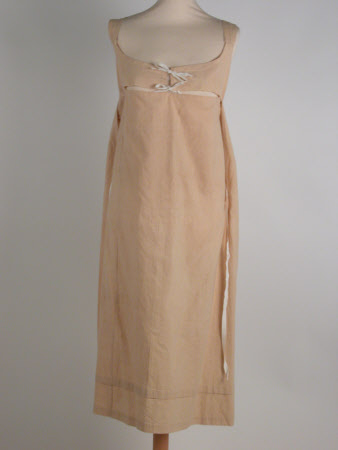I never follow recipes when I cook. Even when it’s something I’ve never made before. My process is this: I get an idea about something I want to make. Then I Google around and read a bunch of different recipes. I read techniques, I watch videos. I might look up something in a cookbook I have, if relevant. I’ll read comments on online posts from people who have done substitutions, and how they adapted the recipe. THEN after a couple of hours of researching and thinking I’ll have a vague idea of what I want, and I’ll gather ingredients, and get cooking. I’ll watch how the ingredients behave when activated and I’ll adjust on the fly. I’ll set timers but always check for doneness/browning/delicious smells. In other words, recipes, to me, are a guideline only, not a formula.
Aaaaand that brings me to sewing…
My first hand-sewing historical garment was a Regency-era shift and it turned out pretty good! I only messed up the sleeve gussets once. 😀 I was feeling pretty confident!
My next project, I decided, would be the next layer out — a bodiced petticoat, lightly boned, to wear instead of stays. For this era, there’s evidence that some women eschewed stays in favor of lighter support garments. I was very inspired by this extant bodiced petticoat (National Trust, Killerton, Devon Collection, NT 1359303).

Very simple ties at the front, ties at side waist to close front flap, and the gathered back skirt is sewn into the bodice.
No pattern? No problem! I had one for a day gown that closed in the back with buttons. A little math, a little fitting, and I should be good to go, right?
I’ll wait while you finish laughing.
Three weeks and four mock-ups later, I’ve got… well, something, at least.
What I SHOULD have done, probably, is followed these instructions for adapting the front-closing bib gown by Sense and Sensibility. But I didn’t have that pattern, and I didn’t want to buy a whole new pattern. And I thought, hey, it’s just like cooking! I’ll read the directions and adapt!

Hint: It’s not like cooking. At least, it’s not for me, not yet. I can improvise in cooking because I’m pretty familiar with what the ingredients do, and how they will respond to certain techniques. In garment construction, I don’t know how taking an inch off here or switching a back-closing to a front-closing bodice will impact the structure, because I don’t have the experience to understand that. That said… I am cautiously optimistic of how my progress is going!


I’ve got to put in the ties and the eyelets, and I might try to fix the skirt, although I’m out of this fabric (four mock-ups eats up a lot of fabric, it turns out) so I might have to wait on that.
The thing is, though, I LOVED this process. I love the engineering of garment construction, love the puzzle-solving, the iterative process. To me that’s as much fun — maybe more fun? — as wearing it. I find it to be a deeply creative process and it’s given me so much respect for mantua makers who drafted garments on the body without patterns (something I’d like to try myself sometime!) Because I don’t have a sewing machine, I’m also sewing everything by hand, and that’s also a wonderfully meditative process. I’m so intrigued by it that I’m thinking of changing the profession of one of my characters to seamstress.
Good thing I’m not on a deadline, though. If I were I’d be screwed!
Summer vacation is coming soon and I hope to get more progress done on this, and then make the day dress that goes over all this! Stay tuned for more novice costume adventures.